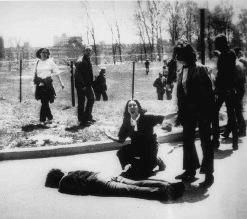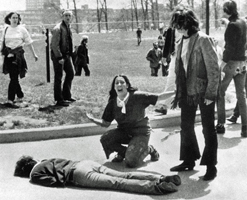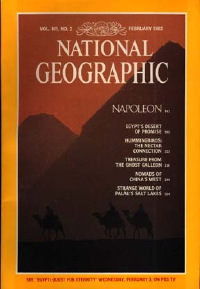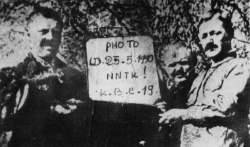 |  |
| HOME | FORUM | REGISTER | LOGIN | HOAXIPEDIA | TOP 100 APRIL FOOLS | COLLEGE PRANKS | ABOUT THE CURATOR |
| A HISTORY OF HOAXES | HOAX WEBSITES | HOAX PHOTO TESTS | GULLIBILITY TESTS | TALL-TALE CREATURES | CONTACT |
About the Hoax Photo Database
The Hoax Photo Database catalogs examples of photo fakery, from the beginnings of photography up to the present. Included in the database are photos that are "real," but which have been suspected of being fake, as well as images whose veracity remains undetermined. The photos are displayed in chronological order (or reverse-chronological). They're categorized by theme, technique of fakery (if known), and time period. See below for the full list of categories.
Other viewing options
View database as Thumbnail Gallery, reverse-chronological or chronological.
The Hoax Photo Database catalogs examples of photo fakery, from the beginnings of photography up to the present. Included in the database are photos that are "real," but which have been suspected of being fake, as well as images whose veracity remains undetermined. The photos are displayed in chronological order (or reverse-chronological). They're categorized by theme, technique of fakery (if known), and time period. See below for the full list of categories.
Other viewing options
View database as Thumbnail Gallery, reverse-chronological or chronological.
Techniques of Fakery
Numerous techniques of image manipulation are now available to photographers. Instead of trying to list every one, we've narrowed them down to a few broad categories.
Time Periods
Numerous techniques of image manipulation are now available to photographers. Instead of trying to list every one, we've narrowed them down to a few broad categories.
- Added Details
- Deleted Details
- False Caption
- Manipulating Existing Details
- Staged Scene
- Trick Angle
Time Periods
This page has been viewed 0 times.
The Missing Pole
Status: Deleted detail
Date: May 4, 1970
Date: May 4, 1970
On May 4, 1970 members of the Ohio National Guard opened fire on anti-war demonstrators at Kent State University. Four students were killed and nine wounded. Student photographer John Filo captured an image (top) of 14-year-old runaway Mary Ann Vecchio screaming with grief as she knelt beside the body of Jeffrey Miller.
The picture became one of the most famous of the twentieth century. Filo won a Pulitzer Prize for it in 1971. But sometime around 1972 an unknown photo editor decided to airbrush out the pole that was awkwardly situated behind Vecchio's head.
The altered image (bottom) replaced the original in the Time-Life Picture Archive and consequently became the standard print used by most publications. Although the de-poled photo ran in many magazines, no one noticed the deletion until May 1995, when it appeared in Life Magazine.
The picture became one of the most famous of the twentieth century. Filo won a Pulitzer Prize for it in 1971. But sometime around 1972 an unknown photo editor decided to airbrush out the pole that was awkwardly situated behind Vecchio's head.
The altered image (bottom) replaced the original in the Time-Life Picture Archive and consequently became the standard print used by most publications. Although the de-poled photo ran in many magazines, no one noticed the deletion until May 1995, when it appeared in Life Magazine.
References:
Mystery of the Missing Pole -- Solved!, National Press Photographers Association email listserver (via Web Archive).
Mystery of the Missing Pole -- Solved!, National Press Photographers Association email listserver (via Web Archive).
Francis Hetling’s Victorian Waifs
 |
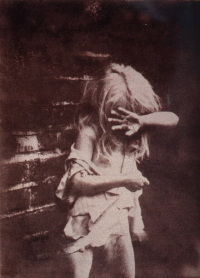 |
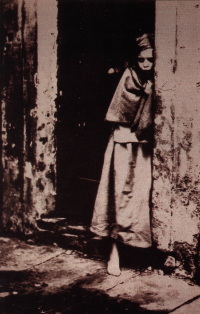 |
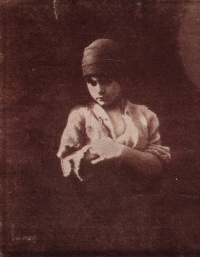 |
Status: Fake (staged & artificially aged)
Date: 1974
Date: 1974
In July 1974 London's National Portrait Gallery hosted an exhibition titled "The Camera and Dr Barnardo." It was principally devoted to pictures of orphans from the Barnado homes, but it included seven prints of Victorian waifs taken by a previously unknown photographer, Francis Hetling. The prints were said to date back to the 1840s. The photos generated excitement among collectors because most photographs from that period showed well-to-do people. It was quite rare to encounter images of the urban poor.
The truth was revealed in 1978. The photos were actually taken by advertising photographer Howard Grey in early 1974 using child models who had posed for him near London's King's Cross station. Grey, inspired by the booming market for nostalgia, had been attempting to take photos with a pseudo-Victorian look. He had then given copies of the photos to Graham Ovenden, an artist and collector of Victorian photography. Ovenden, without Grey's knowledge, rephotographed the images to look like calotypes, a photographic process used until 1860. Ovenden then presented the photos to the National Portrait Gallery, claiming they were genuine Victorian prints.
Grey and Ovenden were later charged with fraud by a collector who claimed to have bought ten Hetling prints from Ovenden. At the trial, Ovenden described his creation of the fictitious Francis Hetling as nothing more than a joke on the art establishment that had gotten out of hand. He said that he wanted to expose the indifference of the art world to contemporary talent, explaining that, "living photography is a fine thing, not only when it entails age." Grey and Ovenden were both acquitted.
Shown are four "Hetling" photos. Experts later pointed out details that should have raised red flags. For instance, the cringing girl (in the photo second from top) would have had to hold that pose for several minutes if it were taken with a camera from the 1840s. It was also noted that the girl in the bottom photo appeared strangely chubby for a waif. Nevertheless, experts admitted that the case demonstrated the ease with which old photographs could be faked.
The truth was revealed in 1978. The photos were actually taken by advertising photographer Howard Grey in early 1974 using child models who had posed for him near London's King's Cross station. Grey, inspired by the booming market for nostalgia, had been attempting to take photos with a pseudo-Victorian look. He had then given copies of the photos to Graham Ovenden, an artist and collector of Victorian photography. Ovenden, without Grey's knowledge, rephotographed the images to look like calotypes, a photographic process used until 1860. Ovenden then presented the photos to the National Portrait Gallery, claiming they were genuine Victorian prints.
Grey and Ovenden were later charged with fraud by a collector who claimed to have bought ten Hetling prints from Ovenden. At the trial, Ovenden described his creation of the fictitious Francis Hetling as nothing more than a joke on the art establishment that had gotten out of hand. He said that he wanted to expose the indifference of the art world to contemporary talent, explaining that, "living photography is a fine thing, not only when it entails age." Grey and Ovenden were both acquitted.
Shown are four "Hetling" photos. Experts later pointed out details that should have raised red flags. For instance, the cringing girl (in the photo second from top) would have had to hold that pose for several minutes if it were taken with a camera from the 1840s. It was also noted that the girl in the bottom photo appeared strangely chubby for a waif. Nevertheless, experts admitted that the case demonstrated the ease with which old photographs could be faked.
References:
• Linklater, M. (Dec 10, 1978). Faking Out the Collectors. The Washington Post.
• Steinbauer, Mary. (July 1981). "The puzzling case of the faked photographs." Life. 10-14.
• Linklater, M. (Dec 10, 1978). Faking Out the Collectors. The Washington Post.
• Steinbauer, Mary. (July 1981). "The puzzling case of the faked photographs." Life. 10-14.
Yeah Eckerd
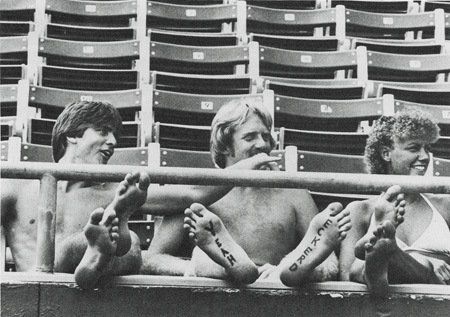
Status: Staged
Date: 1981
Date: 1981
This photo of fans at a college baseball tournament was published in the St. Petersburg Evening Independent. What was not revealed to readers was that the photographer, Norman Zeisloft, had staged the scene by asking the fan to write the phrase "Yeah Eckerd" on the soles of his feet.
With the fan's assent, Zeisloft had first tried to write the phrase himself, but his pen wouldn't write on the man's dirty soles. The fan subsequently washed his feet, wrote the words, and posed for the picture. But unbeknownst to Zeisloft, a rival photographer had taken a photo of him initially trying to write the phrase. This photo is what later implicated Zeisloft in staging the scene.
Zeisloft explained that he had simply not thought it was a big deal since it wasn't a hard-news story. He said, "We set up pictures for society and club news, recipe contest winners, ribbon-cutting and ground-breaking ceremonies, award shots and enterprise features." Nevertheless, the Evening Independent fired him.
With the fan's assent, Zeisloft had first tried to write the phrase himself, but his pen wouldn't write on the man's dirty soles. The fan subsequently washed his feet, wrote the words, and posed for the picture. But unbeknownst to Zeisloft, a rival photographer had taken a photo of him initially trying to write the phrase. This photo is what later implicated Zeisloft in staging the scene.
Zeisloft explained that he had simply not thought it was a big deal since it wasn't a hard-news story. He said, "We set up pictures for society and club news, recipe contest winners, ribbon-cutting and ground-breaking ceremonies, award shots and enterprise features." Nevertheless, the Evening Independent fired him.
References:
• Gordon, J. (Nov 1981). Fired. News Photographer: 31-36.
• Lester, P. (1991). Photojournalism: An Ethical Approach. Lawrence Erlbaum Associates: 115, 118.
• Gordon, J. (Nov 1981). Fired. News Photographer: 31-36.
• Lester, P. (1991). Photojournalism: An Ethical Approach. Lawrence Erlbaum Associates: 115, 118.
The Case of the Moving Pyramids
Status: Fake (digitally altered)
Date: February 1982
Date: February 1982
During the early 1980s, many magazines and newspapers began to use digital imaging devices to manipulate photographs. The most popular such device was sold by Scitex America. The machines were very expensive, but they allowed images to be altered with far greater ease than darkroom techniques allowed.
One of the earliest high-profile instances of digital photo alteration appeared on the February 1982 cover of National Geographic (top), which showed a camel train walking in front of the Pyramids of Giza. Readers weren't informed that the pyramids had been moved slightly closer together, in order to fit the vertical format of the cover. No one might have noticed if the photographer, Gordon Gahan, hadn't complained. It then became a source of major controversy. Sheila Reaves, a journalism professor at the University of Wisconsin has speculated that, "The enormity of moving such a large object brought home to people that you can move a shoulder or a smile."
Less remarked upon was that the photo was also staged. The camel train had walked by while Gahan was setting up his equipment. He paid them to walk by again.
Bottom: another shot of the pyramids from the same photo shoot by Gahan. In this photo, the pyramids haven't been moved.
One of the earliest high-profile instances of digital photo alteration appeared on the February 1982 cover of National Geographic (top), which showed a camel train walking in front of the Pyramids of Giza. Readers weren't informed that the pyramids had been moved slightly closer together, in order to fit the vertical format of the cover. No one might have noticed if the photographer, Gordon Gahan, hadn't complained. It then became a source of major controversy. Sheila Reaves, a journalism professor at the University of Wisconsin has speculated that, "The enormity of moving such a large object brought home to people that you can move a shoulder or a smile."
Less remarked upon was that the photo was also staged. The camel train had walked by while Gahan was setting up his equipment. He paid them to walk by again.
Bottom: another shot of the pyramids from the same photo shoot by Gahan. In this photo, the pyramids haven't been moved.
References:
Kiel, Judy. Who Moved My Pyramid? An Overview of Digital Imaging Ethics in Photojournalism. (pdf file)
Kiel, Judy. Who Moved My Pyramid? An Overview of Digital Imaging Ethics in Photojournalism. (pdf file)
Technique: Rotating or Moving Details, Staged Scene. Time Period: 1980-1999.
Themes: Architecture, Magazine Covers, Photojournalism,.
Themes: Architecture, Magazine Covers, Photojournalism,.
Sinking Bus

Status: Real
Date: Mar. 3, 1988
Date: Mar. 3, 1988
A Number 26 double-decker bus fell into a hole on Earlham Road in Norwich, UK. The hole had been created by a collapsing chalk mine beneath the road. No one was hurt. An unknown photographer then took this picture. The image was not manipulated (although people often think it has been). The picture was subsequently used by Cadbury's to promote their "Double Decker" chocolate bar, with the tagline "Nothing fills a hole like a Double Decker." The image has also circulated widely on the internet.
References:
The Bus That Uncovered a Norwich Chalk Mine, (May 15, 2006). BBC.
The Bus That Uncovered a Norwich Chalk Mine, (May 15, 2006). BBC.
Time Period: .
Themes: Real But Suspected Of Being Fake,.
Themes: Real But Suspected Of Being Fake,.
The Disappearing Coke Can
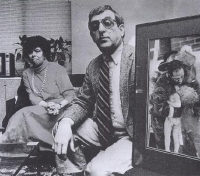 |
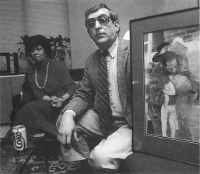 |
Status: Deleted detail
Date: March 31, 1989
Date: March 31, 1989
The top picture appeared on the front page of the St. Louis Post-Dispatch. It showed amateur photographer Ron Olshwanger celebrating in the office of the paper's managing editor after being awarded the Pulitzer Prize for spot-news photography. The prize had been awarded to him for a picture (the one visible in the foreground) which he had taken the previous year showing a firefighter trying to save a 2-year-old girl. His wife, Sally, could be seen behind him. What couldn't be seen was the can of Diet Coke that had originally sat prominently on the table in front of him.
The bottom image is the original version of the photograph, with the can. The significance of the can was that Olshwanger was a teetotaler, so he wasn't celebrating his award with champagne. But an editor at the Post-Dispatch thought the can ruined the composition of the photo, so he ordered its removal. Apparently he meant for the photo editors to remove it by cropping it out (an accepted journalistic practice). Instead, they made it vanish by using a Scitex Machine to digitally delete it.
The bottom image is the original version of the photograph, with the can. The significance of the can was that Olshwanger was a teetotaler, so he wasn't celebrating his award with champagne. But an editor at the Post-Dispatch thought the can ruined the composition of the photo, so he ordered its removal. Apparently he meant for the photo editors to remove it by cropping it out (an accepted journalistic practice). Instead, they made it vanish by using a Scitex Machine to digitally delete it.
References:
Wheeler, T. (2002). Phototruth or Photofiction? Ethics and Media Imagery in the Digital Age. Lawrence Erlbaum Associates: pgs. 114-115.
Wheeler, T. (2002). Phototruth or Photofiction? Ethics and Media Imagery in the Digital Age. Lawrence Erlbaum Associates: pgs. 114-115.
Oprah’s Head Transplant
 |
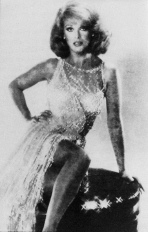 |
Status: Fake (composite)
Date: August 26, 1989
Date: August 26, 1989
Oprah Winfrey appeared on the cover of TV Guide (top) lounging in a gauzy dress on top of a pile of money. She looked glamorous, but only the head belonged to her. The body came from a 1979 publicity shot of Ann-Margret (bottom -- original in color) taken for a Rockette special.
The composite was created without the permission of either Oprah or Ann-Margret, and was detected when Ann-Margret’s fashion designer recognized the dress. Ann-Margret’s publicist said, “If you look at the two pictures, they’re identical. It’s even her ring on Oprah’s hand.” Oprah Winfrey’s spokesman said, “Oprah would not pose on a pile of money like that nor would she pose in that revealing a dress.” TV Guide instructed the artist who created the photo “not to use photographs so literally” in the future.
The composite was created without the permission of either Oprah or Ann-Margret, and was detected when Ann-Margret’s fashion designer recognized the dress. Ann-Margret’s publicist said, “If you look at the two pictures, they’re identical. It’s even her ring on Oprah’s hand.” Oprah Winfrey’s spokesman said, “Oprah would not pose on a pile of money like that nor would she pose in that revealing a dress.” TV Guide instructed the artist who created the photo “not to use photographs so literally” in the future.
References:
Lester, P. (1991). Photojournalism: An Ethical Approach. Lawrence Erlbaum Associates: pg. 126.
Lester, P. (1991). Photojournalism: An Ethical Approach. Lawrence Erlbaum Associates: pg. 126.
Technique: Composite Images. Time Period: 1980-1999.
Themes: Celebrities, Digital Plastic Surgery, Head Transplants, Magazine Covers, Striking a Pose,.
Themes: Celebrities, Digital Plastic Surgery, Head Transplants, Magazine Covers, Striking a Pose,.
Madonna’s Gapless Glamour
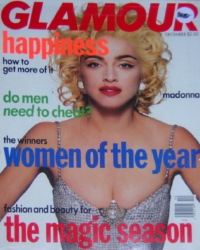
Status: Fake (digital plastic surgery)
Date: December 1990
Date: December 1990
The photo editors at Glamour did some digital dental work on Madonna, closing the gap between her front teeth in her cover photo. Madonna was upset when she saw the finished cover and demanded the gap be restored. But it was too late. The magazine had already gone to print.
Missing in Action
Status: Fake (composite)
Date: July, 1991
Date: July, 1991
The top photo made national headlines when it surfaced in July, 1991. It appeared to show three American fliers, who had been listed as missing during the Vietnam War, holding a sign with the date 25-5-90. The implication was that the men were still alive somewhere in south-east Asia.
The families of the men were convinced the photo was authentic, but Pentagon officials had doubts. They noted the men looked unusually well nourished for having been in captivity for two decades; the sign they were holding appeared to have been pasted into the photo; and the source of the photo was dubious. It had been faxed to the Pentagon by a man of Cambodian descent living in Los Angeles who, in turn, said he had received it from a former prison guard living in Phnom Penh. $2 million was being demanded to help arrange the return of the fliers.
The Pentagon sent a team to Thailand to investigate. They eventually discovered the true source of the photo. It was a doctored version of a 1923 photograph (bottom) of three Soviet farmers which had been published in the December 1989 issue of a Khmer-language magazine called Soviet Union. The con artists had cropped the original image, added moustaches to the men, and pasted in the sign.
The families of the men were convinced the photo was authentic, but Pentagon officials had doubts. They noted the men looked unusually well nourished for having been in captivity for two decades; the sign they were holding appeared to have been pasted into the photo; and the source of the photo was dubious. It had been faxed to the Pentagon by a man of Cambodian descent living in Los Angeles who, in turn, said he had received it from a former prison guard living in Phnom Penh. $2 million was being demanded to help arrange the return of the fliers.
The Pentagon sent a team to Thailand to investigate. They eventually discovered the true source of the photo. It was a doctored version of a 1923 photograph (bottom) of three Soviet farmers which had been published in the December 1989 issue of a Khmer-language magazine called Soviet Union. The con artists had cropped the original image, added moustaches to the men, and pasted in the sign.
References:
Brugioni, D. (1999). Photo Fakery. Brassey's: pgs. 64-65.
Brugioni, D. (1999). Photo Fakery. Brassey's: pgs. 64-65.
White Hot Mama
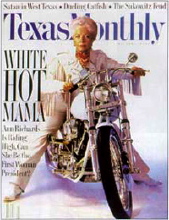
Status: Fake (composite)
Date: July 1992
Date: July 1992
Ann Richards, then governor of Texas, appeared on the cover of Texas Monthly in a “Bad Girl” pose astride a white-and-chrome Harley-Davidson. However, Richards had not posed for the photo. Instead, it was created by combining a stock photo of her head with a picture of a model. Texas Monthly had approached Richards about posing for an actual shot, but had decided to create a composite because the governor was unable to schedule enough time for a photoshoot. Richards later said that she loved the cover photo.
Technique: Composite Images. Time Period: 1980-1999.
Themes: Head Transplants, Magazine Covers, Politics, Striking a Pose,.
Themes: Head Transplants, Magazine Covers, Politics, Striking a Pose,.
